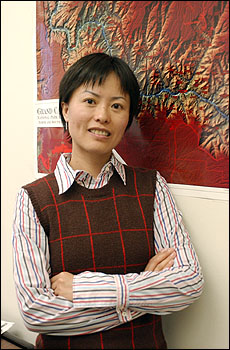Archives
Yin blends high-tech with planning
New architecture-and-planning faculty member favors an interdisciplinary approach
By IRENE LIGUORI
Reporter Contributor
Li Yin doesn't want to be characterized purely as an urban planner. And she's not just a cutting-edge technology whiz, either. She's both of those things—and a whole lot more.

Li Yin left China to pursue her
education in America because the philosophy of planning in her home
country is so dramatically different from what she wanted to
study.
PHOTO: NANCY J. PARISI
Yin, who joined the faculty of the School of Architecture and Planning last August, holds a B.A. in architecture from Yunnan Polytechnic University in China (1992), an M.Sci. in urban planning, land and housing development from the Asian Institute of Technology in Thailand (1998) and a Ph.D. in design and planning from the University of Colorado at Denver (2004).
She says she chose UB over other American institutions because only UB provided her with the opportunity to meld her high-end technology, design and planning backgrounds in new and useful ways.
Other universities seemed less interested in an interdisciplinary approach, she says.
"It is very hard to find a job like this," says Yin, who left China to pursue her education and research in America because the philosophy and direction of planning in her home country is so dramatically different from what she yearned to study.
Her research focuses on computer-technology applications in a wide variety of urban-growth issues and inner-city redevelopment, as well as environmental impact analysis. She is interested in exploring new planning tools that enable a high level of visualization, simulations, 3-D modeling and database management. All of those tools can be used to help community policy makers better communicate when evaluating alternatives and increase efficiency of planning processes.
Specifically, Yin has vast experience in spatial modeling and analysis using GIS (geographic information systems), spatial econometrics using SpaceStat, statistical packages SPSS and LIMDEP, database software such as SQL Server and Access, and programming in AML, VB and Java.
She notes that she was drawn to UB in part by the fact that a national GIS center—one of a handful in the United States—is located here at the university. Such centers are extremely important sources of information when building urban growth models, according to Yin. Her colleagues in the Department of Urban and Regional Planning represent a good mix of specialists in engineering, physics and geography, she says, and all are productive.
"That gives me some pressure to be productive—in a good way," she says, laughing.
During the spring semester, Yin taught two courses in urban simulation, and notes that she was impressed that her students consistently did much more work than she required—"spending hours and hours" working in tandem with UB's Center for Computational Research and the New York State Center for Engineering Design and Industrial Innovation to do 3-D visualization projects.
Yin's work has a public service aspect. One summer in Colorado, when summer wildfires were particularly bad, she was struck by the plight of a colleague who worried day-to-day about whether her home would be consumed by encroaching flames. One of Yin's projects subsequently revolved around urban-growth modeling and the assessment of potential fire risk to people and property across the American West.
"People don't necessarily make rational choices about where to live," says Yin. She examined in her model the reasons why commuters and second-home owners go out of their way to locate their homes in areas almost certain to be vulnerable to wildfires.
She's also studied housing density in Western ski resort areas, and in Santa Barbara, Calif., where there is a great deal of high-quality agricultural land. Yin built an alternate-growth futures model to look at where people will be building homes in years to come.
In Buffalo, Yin says she is interested particularly in studying growth patterns, urban sprawl and racial segregation. She also has co-written a proposal with a department colleague to do a pilot study for NIH examining obesity in Western New York in 12- to 14-year-olds who have access to public parks. That proposal also has the support of UB's Interdisciplinary Research and Creative Activities Fund.
Yin recently presented a session on agent-based models in Denver, and last fall delivered a paper entitled "Recreation Development and Urbanization in the New West: Models of Density Increase" at the annual conference of the American Collegiate Schools of Planning in Portland, Ore.
Other topics of research interest on which she has presented recently are the influence of amenities on exurban growth, the role of micro-markets in exurban residential development, applications of alternative growth futures in resort communities and Logit regression techniques in urban-growth modeling.
Yin enjoys the outdoors—biking, walking, gardening and playing tennis. She belongs to the Association of Collegiate Schools of Planning and the Association of American Geographers.
